
EPE2012 conference in Brno, Czech Republic: Focus on fusion.
The international scientific conference EPE (Electric Power Engineering) 2012 took place from 23-25 May, in Brno, in the Czech Republic. This annual conference, now in its thirteenth year, was organised by the Department of Electrical Power Engineering at the Faculty of Electrical Engineering and Communications of Brno University of Technology. The conference is dedicated to analysis and discussion of problems relating to power engineering in the area of science, research and work experience. It provides an excellent platform for the exchange of information, focused debate and networking among those who work in industry, education and research.
Among the many interesting papers presented during the conference was the following detailed report written by Ondrej Zlamal on some of the fusion-related devices operated at the Rez Nuclear Research Institute, near the Czech capital, Prague.
(The Editor-in-Chief)
Experimental capacities on LVR-15 research reactor for applied research on fusion components
By Ondřej Zlámal: Centrum Výzkumu Řež s.r.o., Section 8100, Department 8140, Husinec-Řež, čp. 130, 250 68 Řež, Czech Republic, www.cvrez.cz tel: +420 266 172 337, email: zla@cvrez.cz
Abstract
Paper introduces experimental devices on LVR-15 reactor with focus on capacities on field of fusion applications. CV Rez is involved in two fundamental R&D activities for fusion devices and ITER, in particular: durability of plasma-facing materials is tested for "Blanket" section and tritium extraction from Pb-Li melt is investigated for "Test Blanket Module" section, both from ITER project.
Paper provides basic insight on TW3 rig, BESTH device and MeLiLo loop, the three testing and experimental devices for fusion. Results, engineering obstacles and achieved goals are presented along with perspectives for future development.
Keywords: fusion, LVR-15, experimental devices
-
Introduction
Centrum Výzkumu Řež s.r.o. (hereinafter referred as Research Centre Rez, abbreviated as RCR), the daughter company and successor of Ústav jaderného výzkumu Řež a.s. (hereinafter referred as Nuclear Research Institute, abbreviated as NRI) on the field of research reactor’s operation and development of experimental devices has extensive experience in exploitation of out-of-pile and in-pile experimental devices for fusion applications. NRI and RCR’s employees gained such experience in several task and grants carried out for EU-based fusion-related agencies such as European Fusion Development Agreement (EFDA) and Fusion For Energy (F4E). Strong background of many years of reactor water loop’s operation should be also taken in account.
This paper deals mostly with fusion-oriented experimental and testing devices operated in Řež:
-
BESTH device,
-
MeLiLo loop,
-
TW3 rig.
-
Origins of fusion research in Řež
First deeper involvement with fusion research was made in 2002, when NRI was approached by EURATOM-IPP.CR Association with offer on participation in EFDA Programme.
EURATOM-IPP.CR consists of four institutes of Academy of Science of the Czech Republic (Institute of Plasma Physics, J. Heyrovský Institute of Physical Chemistry, Nuclear Physics Institute and Institute of Physics of Materials), two prestigious faculties of Czech universities (Faculty of Mathematics and Physics under the Charles University in Prague and Faculty of Nuclear Sciences and Physical Engineering under the Czech Technical University) and two commercial research subjects (NRI and Institute of Applied Mechanics Brno, Ltd.); in total EURATOM-IPP.CR can provide about 80 scientists and technicians dedicated to fusion research.
EURATOM-IPP.CR’s utilization of NRI -and later RCR- capacities for participation on EFDA research programme was mainly based on fact that NRI operated the strong source of neutrons, the LVR-15 research reactor, and has long-term experience with development, operation and evaluation of its experimental devices. Certain tasks under EFDA’s Work Programme for 2003 year required material irradiation up to several dpa (displacement per atom, measure of absorbed dose from particle flux, most often neutrons), which cannot be obtained from other neutron sources in reasonable time-frame. The first EFDA task delivered to NRI through the EURATOM-IPP.CR was focused on the EUROFER 97 corrosion investigation under the neutron irradiation and was followed by HIP joint studies under the cyclic heat load.
In the first years, NRI involvement in EFDA tasks was mostly aimed on the investigation studies under the Test Blanket Module (hereinafter referred as TBM). TBM is one of in-vessel components planned for ITER tokamak; its purpose is circulation of lithium-enriched lead, which transmutes tritium 3H, once irradiated by fusion-generated neutrons. Tritium is then extracted, purified and used as a fuel for fusion reaction. Such applications have very high demands on used materials, mainly the construction steels. NRI offered experimental facilities for testing EUROFER 97 steel and by 2002 its specialists started to develop and later operate PbLi in-pile rig, which circulated liquid PbLi melt around EUROFER 97 samples. Inconsiderable results with EUROFER 97 steel were obtained from performed investigations as given in [17, 20, 21, 22].
Year after, EUROATOM-IPP.CR Association became interested on another field of EFDA research: testing of First Wall mock-ups (often abbreviated as FW or PFW, where PFW stands for Primary First Wall and means testing of materials which are expected to be used only in first, not-final version of First Wall). NRI received another EFDA task, which focused on thermal cycling of joint between beryllium tiles and copper alloy in the in-pile environment. This task was later followed by another one, more urgent, where slightly larger mock-ups were tested out-of-pile. Both tasks required development and building of unique devices, which are described down in the text.
At the break of 2007, the Fusion For Energy (F4E) was established as the EU’s joint undertaking for ITER and development of fusion energy.
Contrary to EFDA, F4E is aimed on commercial procurement of selected components, services and systems for ITER; by its nature, F4E took over few of former EFDA tasks, which were performed in NRI. Transferred tasks had partly commercial background and their governance by F4E was generally welcomed.
-
Recent fusion-related experimental capacities
As given above, since 2002 several EFDA tasks were carried out in NRI, both in-pile (in the LVR-15 reactor) and out-of-pile (without irradiation from LVR-15 reactor). In frame of three of them, experimental and testing devices were developed and commissioned for full-power operation. In chronological order, the following tasks were realized in NRI and RCR:
-
TW3-TVB-INPILE: Development, commissioning and operation of the rig for in-pile thermal fatigue testing of two actively cooled mock-ups to check the effect of neutron irradiation on the Be/CuCrZr joint under the representative PFW operation conditions.
-
TW4-TVB-TFTEST2: Development and commissioning of out-of-pile testing device for long-term thermal fatigue testing of actively cooled mock-ups.
-
TW5-TTBC-005: Development of key components for PbLi Ancillary system.
All above given tasks resulted in development, manufacturing and commissioning and later operation of following experimental devices:
-
TW3 rig was developed under the TW3-TVB-INPILE task. TW3 rig is the only device of all three discussed in this paper operated in-pile.
-
BESTH device was developed under the TW4-TVB-TFTEST2 task. BESTH is abbreviation for Beryllium Sample Thermal testing. BESTH device is operated out-of-pile and partly served as technology testing for TW3 rig.
-
MeLiLo was developed under the TW5-TTBC-005task. MeLiLo stands for Metal Liquid Loop and is operated out-of-pile.
3.1
TW3 rig
Even though TW3-TVB-INPILE task was received as the first one of all discussed, its complexity and demands postponed its finishing after the successful ending of both above mentioned tasks.
The objectives of TW3-TVB-INPILE task were to develop, construct, commission and operate in-pile rig for continuous cyclic thermal fatigue loading of Be/CuCrZr joint on actively cooled FW mock-ups. The measures of merit were set as 20 000 thermal cycles up to 0.5 MW/m2 heat flux and 0.6 dpa of absorbed neutron dose.
The reason for investigation of effects of thermal cycling under the irradiation conditions is to simulate FW materials performance under the expected operation mode of ITER: in general, it is anticipated that ITER will be most likely operated in approx. 400 seconds long pulses as given in [18, 19]. Pulse operation generates thermal shocks on used FW materials, which have to withstand significant heat and neutron fluxes during the start-up and cool-off transients of each pulse. Especially HIP joint between plasma armour (Beryllium) and heat sink material (Copper alloy) is under extreme load: HIP stands for Hot Isostaic Pressing, diffusion joining technique, where two materials are bond together at pressures above 100 MPa and temperatures above 550°C for several hours. During the HIP bonding, diffusion joint between both materials is made, but it must be qualified for ITER operation, meaning thermal fatigue and radiation damage. As given in [7, 24], in-pile testing of FW materials is ongoing worldwide with single important goal: to investigate performance of materials under conditions as close to ITER as possible. In particular the effect of radiation degradation is of highest importance as such deterioration can not be simulated by other means.
It should be mentioned NRI and later RCR were assigned to investigate influence of given neutron source on selected materials; no consideration of different spectra on LVR-15 reactor and ITER were required from EFDA/F4E even though such difference appears to be crucial: thermal neutron source such as LVR-15 research reactor can not simulate fast neutron spectrum with 14 MeV peak, which is typical for fusion devices. As given in [23], LVR-15 neutron lethargy fluency decreases significantly before reaching 10 MeV and almost no >10 MeV neutrons are available in any irradiation position of the LVR-15 reactor. Such fact must be taken in account when evaluating results of irradiated mock-ups; EFDA TW3-TVB-INPILE task did not required any consideration of different neutron spectra and often inquiries from NRI/RCR to EFDA/F4E were not clearly answered. With no official recognition of this issue, it is commonly accepted that reason for using thermal spectrum instead of fast + 14 MeV peak spectrum lays in deficiency in reliable fusion devices and excess of research reactor’s irradiation capacities.
On advice of EFDA scientific unit, the heating with graphite panel was used as generator of required heat flux in TW3 rig. Its advantages lay mostly in using of DC current, relatively high resistance to neutron deterioration, simple design and related low operation and construction costs. As the task goes on, the biggest disadvantage seems to be in impossibility to perform even the simplest repairs on the rig itself: once inserted in the LVR-15’s core and irradiated, the rig is forbidden for any manipulation except the final irreversible disassembling, when the rig is cut open and irradiated mock-ups are retrieved by means of cutting from rig’s internal installation.
In the first years of TW3-TVB-INPILE task, the various designs of heating panel and used graphite grades and insulating ceramics were investigated, resulting in selection of meander-shaped R 8710 isostatic graphite grade panel with Si3N4 low Yttrium doped ceramics as given in [3, 4, 5, 9]. Such selection was supported by results from TW6-TVM-TFTEST and TW4-TVB-TFTEST2 tasks performed on BESTH device and also by experience gained during out-of-pile testing of TW3, when several types of ceramics and graphite grades were tested.
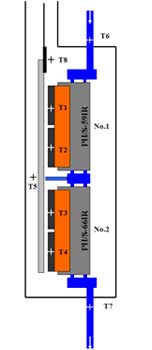
Fig. 1: TW3 rig schematics
Due to limited space in LVR-15 core and dimension of irradiated mock-ups, the serial setting of both mock-ups was used: the mock-ups are connected by middle mixing block; the cooling water enters the upper mock-up first and then passes through the lower mock-up to the reactor pool. It should be mentioned that reactor pool water is used for cooling instead of the separated cooling circuit as used on other experimental devices. Due to mock-up dimensions and requirements on low heat losses, TW3 rig occupies two cells in the reactor core.
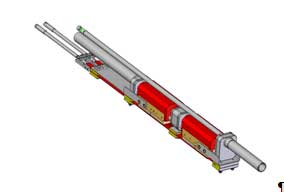
Fig 2: 3D model of TW3 rig without metal sheath
Serial connection of both mock-ups led to development of plane and thin heating panel, which is placed on top of Beryllium tiles as given on Fig. 1. The Beryllium tiles are given in black, CuCrZr alloy in orange, stainless steel body of both mock-ups is dark grey, heating panel is light grey and cooling water pipes are printed in blue. Position of measuring thermocouples is also given. As shown on Fig. 1, the 1-2 mm gap between Beryllium and heating panel ensures no short electric circuits leak into the mock-up bodies but on the other hand heat losses are kept as low as possible.
In frame of TW3-TVB-INPILE, the TW3 rig was tested out-of-pile in two shorter screening tests, totalling about 6 000 cycles. Screening tests were performed in order to verify TW3 rig’s design, power conditions and gather data for in-pile operation. Such data were later used for application to the Czech nuclear regulator, State Office for Nuclear Safety (SUJB), which is the governing body over the nuclear safety on all nuclear installations in Czech Republic, including LVR-15 research reactor. TW3 rig is experimental installation with significant impact on nuclear safety; hence the approval from SUJB was required for its in-pile operation. Such approval was obtained on the eve of 2011 and since January 2012 the TW3 rig is in full operation. TW3 rig was operated in-pile for the first time in K136 reactor campaign, in position D1/D2 as shown on Fig. 3, see [6], where purple cells represent IRT-4M fuel (with control rods if marked with central point), white “B” cells stand for Beryllium reflector and green dotted cells are water displacers; central section on D4/D5 and E4/E5 in the core was filled with Iridium irradiation cells with central void in Beryllium reflector; cells C10/C9 and D10/D9 are long time occupied with DONA irradiation channel for Silicone doping.
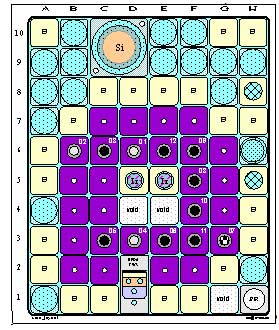
Fig 3: K136 core with TW3 rig in position D1/D2
Similar to out-of-pile operation, TW3 rig generates 7 minutes long cycles during the in-pile operation. The DC powered heating graphite panel needs 30 seconds to heat to full power (9.2 kW), 180 seconds to keep full power, 30 second to cool down to zero power and 180 seconds to keep on zero power. The full power is computed to generate 0.5 MW/m2 over the whole Beryllium surface, which was also measured on calorimetry of cooling water during the out-of-pile screening tests.
The TW3 rig is operated only with LVR-15 reactor on full power; as a result, significant radiation heat is generated in all rig materials. Metal sheath, which is in direct contact with reactor pool’s water, is cooled independently and almost no heat is transferred from it to the mock-up due to helium atmosphere around the mock-ups. Similarly almost all radiation heating generated in mock-ups is removed by its cooling circuit where flow-rate, inlet and outlet temperatures are measured for calorimetric evaluation.
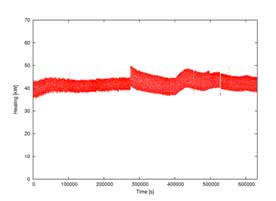
Fig 4: Calorimetric data recorded during K136 reactor campaign
Although the radiation heating strongly depends on fuel burn-up, fuel loading pattern and mostly also on the position of reactor control rods, as indicated on Fig. 3, it was evaluated that average radiation heating power of 38.77 kW with 0.98 kW of standard deviation is generated in the rig as given on Fig. 5, excluding metal sheath which is cooled independently; see [5, 6] for further details. The recorded calorimetric heat from K136 campaign

Fig 5: Distribution of radiation heating during K136 reactor campaign
With total weigh of rig irradiated materials as 5 615 g, it can be calculated that average radiation heating rate is about 6.9 W/g. Relatively high value is still under evaluation and can be explained by presence of elements significantly lighter than Iron, such as Beryllium or Carbon, which moderate neutrons more effectively. Decrease in thermal neutron flux is depicted on Fig. 6: scale given in key on the right ranges from 2·1013 to 2.6·1016 neutrons/cm2/s.
In order to generate 20 000 cycles as required TW3-TVB-INPILE task objectives, TW3 rig is expected to be operated in 6 campaigns, starting with K136 on January 2012 and ending with K141 on June 2012. According to dose calculations performed in MCNPX code with ENDF/B-VII library (MT444 cross section in particular) and methodology from SPECTER program (see [10]) on TW3 rig model given on Fig. 2, it is expected approx. 0.6 dpa will be accumulated in Beryllium by the end of irradiation. Such value is in concurrence with requirements from task objectives.

Fig 6: Thermal neutron flux (En < 0.625 eV) in LVR-15’s core with TW3 rig
After finishing of irradiation, TW3 rig is slated to be kept several months under the water shielding in LVR-15 reactor’s wet depository. During this period, residual heating will be removed and certain radioactivity decrease is expected. Rig will be then cut open, first in LVR-15 reactor’s hot cells, where mock-ups will be retrieved from metal shielding. Second, most precise cutting shall take place in NRI’s semi-hot cells, where smooth ending of each cooling water pipes will be finished. Clean cuts with no metal chips are required as mock-ups are planned for further testing in Forschungszentrum Juelich (FZJ) in Germany on JUDITH device equipped with electron beam. JUDITH device is world-wide unique device (see [11]), which is able to generate heat fluxes up to 20 MW/m2; JUDITH will continue with and finish TW3-TVB-INPILE task.
As mentioned in [7], similar in-pile test with FW mock-ups was carried out in RIAR Dimitrovgrad, in cooperation with NIIEFA Eframov, but only 3700 cycles were reached before the testing rig experienced heating panel’s failure. With several times higher number of generated cycles under the similar similar irradiation conditions, TW3 rig appears to be world-wide unique device.
3.2 BESTH device
BESTH device was developed under the TW4-TVB-TFTEST2 task and served for mock-up testing under the TW6-TVM-TFTEST task as described in [8, 9].
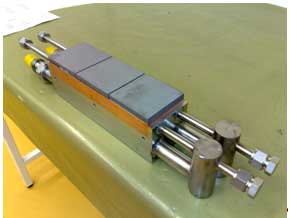
Fig. 7: FW mock-up before testing in the BESTH device
Slightly larger mock-ups were tested in BESTH device than in TW3 rig as it was not limited by LVR-15 core’s dimension restrictions. BESTH device is stand-alone testing installation housed in Beryllium Laboratory in Mala Chemie building, next to the LVR-15 premise.
BESTH device consists of two glove boxes connected to separate cooling system; inside of each glove box, the heating vessel is accommodated. Each heating vessel can test 2 mock-ups at once hence 4 mock-ups could by tested in one run. Both glove boxes are connected to separate ventilation system with HEPA filters; whole laboratory is having its own air-ventilation system as well as whole building of Mala Chemie. This assures no Beryllium vapours can be released to environment as they need to be treated as hazardous material.
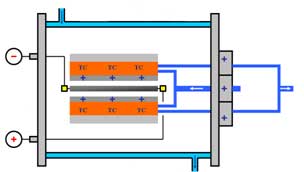
Fig. 8: BESTH heating vessel with 2 mock-ups
In principle BESTH device uses same technology for heating material mock-ups as TW3 rig: DC powered graphite heater is used to generate heat flux of 0.625 MW/m2 which is then removed through the tested mock-ups into the cooling water as referred in [9]. Calorimetric measurement based on cooling water flow-rate and Δt between inlet and outlet water temperature is used for heat flux evaluation, taking in account flat heating profile of whole meander-shaped graphite panel. As the panel is surrounded by two mock-ups, one from each side, only negligible heat is transferred to the heating vessel. Nevertheless heating vessel is actively cooled in order to avoid its overheating after long-time runs (in range of weeks).
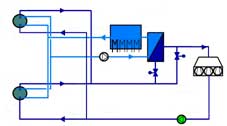
Fig. 9: BESTH cooling circuits
All heating power generated by graphite panel is transferred through the cooling circuit with plate heat exchanger out of laboratory into the cooling mini tower. The returning water is conditioned in order to keep inlet water temperature stable. The scheme of cooling circuit with two heating vessels, heat exchanger, electric heaters and cooling mini tower is shown on Fig. 9.
In frame of TW4-TVB-TFTEST2 and TW6-TVM-TFTEST tasks seven mock-ups were tested. Five of them were standard 12 000 cycles long thermal fatigue tests of FW mock-up from various suppliers: from China, Russian Federation, South Korea, EU and USA, see [1, 2, 14, 15, 16]; last two mock-ups were ordered by F4E for life-time durability test, lasting 30 000 cycles as given in [13]. All mock-ups were tested to heat flux of 0.625 MW/m2 and duration of cycle as 30 seconds heating up, 180 seconds of full power, 30 seconds cooling down and 60 seconds of power off.

Fig. 10: Ultrasonic testing of Be/CuCrZr joint soundness
Each mock-up was non-destructively tested by ultrasonic examination for soundness of Be/CuCrZr joint. Such examination was carried out twice on each mock-up: before commencing of testing in BESTH device and after its finishing. Typical output of ultrasonic testing is given on Fig. 10. It should be mentioned all tested mock-up performed almost flawlessly, including mock-ups from life-tie durability test as given in [1, 2, 13, 14, 15, 16]. Other effects of long-time testing were negligible as shown on Fig. 7 and Fig. 11.
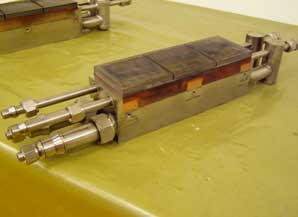
Fig. 11: FW mock-up after testing in the BESTH device
Each tested mock-up was transported for further high heat flux testing in FZJ, where it was tested on JUDITH II device, similarly as described in [1, 2]. Detailed description of JUDITH II is given in [12].
3.3 MeLiLo
At the beginning, NRI involvement in fusion started with interest on the field of EUROFER investigation. Participation on this field was later expanded and in frame of TW5-TTBC-005 out-of-pile loop with PbLi melt was constructed and commissioned under the name “MeLiLo” as given in [17]. The MeLiLo was later also utilized under the task TW6-TTMS-003.
Both tasks focused on further development of TBM; TW5-TTBC-005 aimed on feasibility of TBM technologies, while TW6-TTMS-003 investigated corrosion of EUROFER 97 steel. European efforts on the field of TBM are closely connected with liquid metals, thus need of PbLi loop existed.
MeLiLo is simple pipe loop which circulates PbLi melt in the temperature range of 280-550°C. Such significant temperature drop is necessary for investigation of solubility of PbLi melt’s impurities, mostly corrosion products from wetted pipes. Low temperature is kept in “cold trap”, special column with metal chip filling, which is used for separation of impurities.

Fig. 12: MeLiLo schematics with cold trap and flange test section on left and pump with drain tank on right
The key components of MeLiLo (pump vessel and cold trap vessel) are made of EUROFER 97, other parts are made of DIN 1.4903 (pipes, pump internals, cold trap filling) and CSN 17 xxx grade steel (drain tank and pump impeller wheel). Loop is equipped with several sampling points which allow extract PbLi melt samples before and after the cold trap.
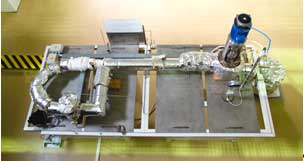
Fig. 13: MeLiLo top view
Under the TW5-TTBC-005 task MeLiLo was successfully utilized for development of key components of TBM Ancillary System such as pump, cold trap and flange, see [17]. Later involvement in TW6-TTMS-003 task was focused on long time (in range of thousands full power hours) operation, when EUROFER 97 samples were examined and investigation on PbLi melt’s corrosion potential was done.
4. Future activities
RCR involvement on fusion field is not over: further EFDA tasks are in negotiation, both on field of FW and TBM, several own projects are carried out under governance of R&D programs from the Ministry of Education, Youth and Sports (MSMT) and Ministry of Industry and Trade (MPO) and most importantly RCR bids for F4E’s call on procurement of full-scale component testing facility, which should be built under the SUSEN project.
Also, in frame of SUSEN project, further utilization of PbLi liquid eutectic’s experience is slated for incoming years: in-scale mock-up of TBM is expected to be built for investigation of remote handling apparatuses.
5. Conclusion
NRI and RCR are active on field of fusion research for last 10 years. Both institutions closely cooperate with EURATOM-IPP.CR Association, EFDA, F4E and other private, public and governmental bodies.
Significant advance in utilization of Rez capacities in fusion was made since beginning of millennium, similar only to advance in fusion as whole. Both NRI and RCR work hard to expand its involvement in fusion and availability of LVR-15 research rector is their biggest asset.
ACKNOWLEDGEMENTS
This article was prepared under the financial support from MSMT EUPRO II project LE11012 “Project of participation support in EFDA fusion programs”. Author wishes to express his gratitude to Michal Koleska for his cooperation on TW3 rig’s radiation heating evaluation and Jaroslav Ernest for providing Figures 3 and 6.
REFERENCES
-
Zacchia, F., Bellin, B., Lorenzetto, P., Bucci, Ph., Frayssines, P.E., Leibold, J.M., Oresic, B., Thomser, C., Schmidt, A., Roedig, M., McDonald, J.M., Lutz, T.J., Youchison, D.L., Ulrickson, M.A., Zlamal, O., Klabik, T., Masarik, V. Fabrication and Testing of the EU FW Qualification Mock-up, 26th Symposium on Fusion Technology, 2010, Porto, Portugal.
-
Zacchia, F. et al Fabrication and Testing of the EU FW Qualification Mock-up, 23rd IAEA Fusion Energy Conference, 2010, Daejon, Republic of Korea.
-
Klabik, T., Zlamal, O., Hajek, P., Zmitkova, J. TW3-TVB-INPILE: In-pile thermal testing device for Primary First Wall Mock-ups with Becladding, Part I: Preparation of the test rig, UJV-Z2678, 2009, Rez, Czech Republic
-
Zlamal, O., Klabik, T., Muhlbauer, P., Bellin, B. TW3-TVB-INPILE: In-pile thermal testing device for Primary First Wall Mock-ups with Be cladding, Part II: Out-of-pile 1000 cycles test run, UJV-Z2817, 2010, Rez, Czech Republic
-
Zlamal, O., Klabik, T., Zmitkova, J., Bellin, B. TW3-TVB-INPILE: In-pile thermal testing device for Primary First Wall Mock-ups with Be cladding, Part III: Out-of-pile 5000 cycles test run, CVR-Z030, 2012, Rez, Czech Republic
-
Zlamal, O., Vsolak, R., Klabik, T., TW3-TVB-INPILE: Start-up and first 100 cycles data on TW3 rig, K136 reactor campaign, CVR-Z060, 2012, Rez, Czech Republic
-
Litunovsky, N., Gervash, A., Lorenzetto, P., Mazul, I., Melder, R. In-pile testing of ITER first wall mock-ups at relevant thermal loading conditions, Journal of Nuclear Materials, vol. 386-388, 2009, pp. 979-982, ISSN: 0022-3115
-
Klabik, T., Zlamal, O., Masarik, V. Description of Thermal Fatigue Testing Equipment for Be coated Primary First Wall Mock-ups, UJV-13213, 2009, Rez, Czech Republic
-
Zlamal, O. Aktivni testovani vzorku PFW, 11. Mikulasske setkani mlade generace CNS, 2011, pp. 72-78, ISBN 978-80-02-02360-9
-
Grenwood, L.R., Smither, R.K. SPECTER: Neutron Damage Calculations for Materials Irradiations, ANL/FPP/TM-197, 1985, Argonne, Illinois, USA
-
Roedig, M., Duwe, R., Ibbott, C., Jacobson, D., Le Marois, G., Lind, A., Linke, J., Lorenzetto, P., Peacock, A., Plochl, L., Schuster, A., Severi, Y., Vieider, G., Visca, E., Weichers, B. Thermal fatigue tests with actively cooled divertor mock-ups for ITER, Fusion Engineering and Design, vol. 39-40, 1998, pp. 551-557, ISSN: 0920-3796
-
Majerus, P., Duwe, R., Hirai, T., Kuhnlein, W., Linke, J., Roedig, M. The new electron beam test facility JUDITH II for high heat flux experiments on plasma facing components, Fusion Engineering and Design, vol. 75-79, 2005, pp. 365-369, ISSN: 0920-3796
-
Zlamal, O., Wikman, S., Klabik, T., Masarik, V., Vsolak, R., Bellin, B. TW6-TVM-TFTEST: Thermal Fatigue Test of Be Coated Primary First Wall Mock-ups (tests), Test Campaigns of 110/80 Wide Mock-ups, CVR-Z031, 2011, Rez, Czech Republic
-
Klabik, T., Zlamal, O., Masarik, V. Final technical test report: FWQ-RF-2, UJV-Z2529, 2009, Rez, Czech Republic
-
Klabik, T., Zlamal, O., Masarik, V. Final technical test report: FWQ-CN-05, UJV-Z2588, 2009, Rez, Czech Republic
-
Klabik, T., Zlamal, O., Masarik, V. Final technical test report: FWQ-KO-2, UJV-Z2530, 2009, Rez, Czech Republic
-
Berka, J., Frybort, O., Hajek, P., Kosek, L., Masarik, V., Splichal, K., Vsolak, R., Burda, J., Keilova, E., Skoumalova, Z. Components of the Helium Cooled Pb-Li Test Blanket Module, internal report, 2011, Rez, Czech Republic
-
How, J. Project Integration Document PID, ITER_D_2234RH, Version 3, 2007, Cadarache, France
-
How, J., Reichle, R. PD – Plant Description, IDM UID 2X6K67, 2009, Cadarache, France
-
Splichal, K., Zmitko, M. Corrosion behaviour of EUROFER in Pb-17Li at 500°C, Journal of Nuclear Materials, vol. 329-333, Part B, 2004, pp. 1384-1387, ISSN: 0022-3115
-
Splichal, K., Berka, J., Burda, J., Zmitko, M. Fracture toughness of the hydrogen charged EUROFER 97 RAFM steel at room temperature and 120°C, Journal of Nuclear Materials, vol. 392, Issue 1, 2009, pp. 125-132, ISSN: 0022-3115
-
Splichal, K., Berka, J., Burda, J., Keilova, E., Lahodova, Z., Masarik, V., Viererbl, L., Zmitko, M. In-pile Corrosion and Radiation Effect Testing of EUROFER Weld Material and Pb-17Li Melt, EFDA Task TW2-TTMS-003b, Final report, UJV-13419M, 2010, Rez, Czech Republic
-
Lahodova, Z., Viererbl, L., Vsolak, R., Zlamal, O. Možnosti využití reaktoru LVR-15 a jeho experimentálního zázemí pro jadernou fúzi, CVR040, 2011, Rez, Czech Republic
-
Roedig, M., Ishitsuka, E., Gervash, A., Kawamura, H., Linke, J., Litunovski, N., Merola, M. High heat flux performance of neutron irradiated plasma facing components, Journal of Nuclear Materials, vol. 307-311, 2002, pp. 53-59, ISSN: 0022-3115
|

